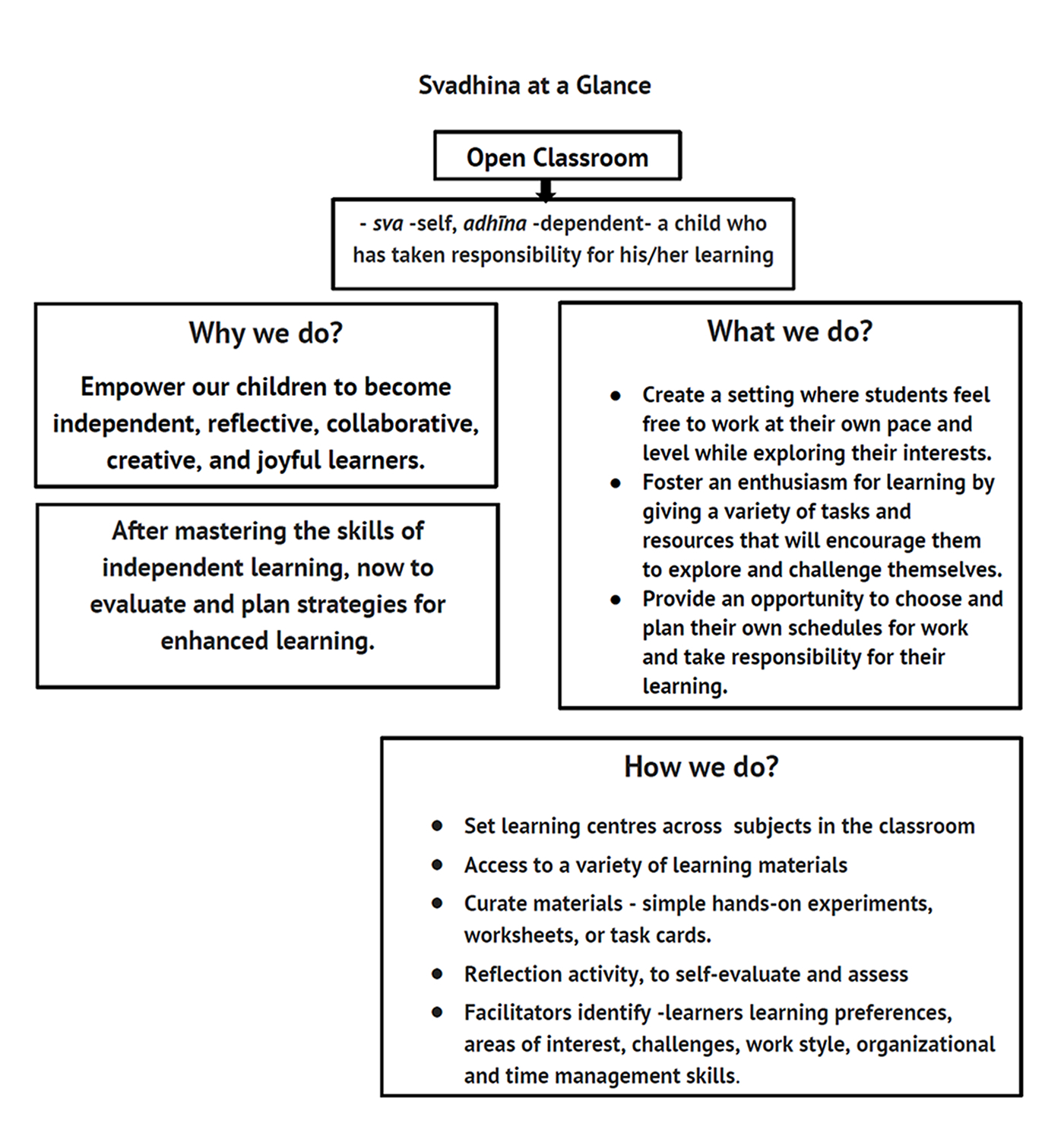Svādhīna – Open Classroom
“It was exciting to move across stations to complete our tasks with no time restrictions.” says Gunn, a grade 3 child, after the Open Classroom session he was a part of. “The children have taken charge of their own learning, I am just a facilitator,” says Ms. Latha. K one of our homeroom faculty.
The best learning takes place when the learner takes ownership of learning. Children are intrinsically motivated natural learners who do not need micromanaging. Independent learning helps children take ownership of their learning. Svadhina -(meaning- sva self, adhīna dependent- a child who has taken responsibility for his/her own learning) the open classroom is an approach towards progressive learning to empower our children to become independent, reflective, collaborative, creative, and joyful learners.
In line with the international curriculum and an approach to holistic education, we have the homeroom set up at the primary level, which aids learners to inculcate independent and reflective learning skills, much like the Cambridge programmes do in learners. In the primary grades, we expose learners to pedagogic practices like the station method that allow them to collaborate and take up tasks in stations within the specified time with minimal guidance from the facilitators. Through this, they build time management and organizational skills. Self-reflection cards with specific rubrics aid the learners to reflect on their learning. We enhance organization and research skills through project-based and experiential learning practices across subjects.
Svadhina -Open classroom, one among the many methodologies used at Hari Shree, is an initiative taken further where learners who have mastered the skills of independent learning, now begin to evaluate and plan strategies for enhanced learning. In open classrooms, we focus on “learning by doing” and cater to the social, emotional, creative, cognitive, and physical needs of every child. In Svadhina the classroom is open with activities across the subjects and the learners are given a platform to explore and choose the activities they would work on independently.
Our aim of the open classroom is to create a setting where learners choose to work at their own pace and level while exploring their interests, foster enthusiasm for learning, and use a variety of resources that aid the learners to explore and challenge themselves. It also aims to provide an opportunity for the learners to choose their own activities, plan their own schedules for work, and take responsibility for their learning. They understand themselves as learners, as Cambridge students do.

We set the classroom with learning centers across subjects and learners are free to move around the classroom with access to a variety of learning materials. This setting emphasizes learning through small-group and individual instruction to encourage collaboration and active learning. Two sessions of Svadhina, are planned in a year, once in term 1 and the other in term 2, with a duration of two and half hours, providing time for the learner to complete the work at their own pace.
The facilitators curate materials based on the skills imparted during the term that include simple hands-on experiments, worksheets, or task cards. After completing the task, they move on to a different task. By the end of the session, learners explore all the centers.
We provide the materials with a reflection activity that allows the learners to self-evaluate and assess themselves. They self-reflect on their performance based on the tasks they have mastered, and the ones that still require improvement.
As the learners work in the learning centers, the facilitators move around to identify their learning preferences, areas of interest, challenges, work style, organizational and time management skills. Based on the observation the facilitators maintain a personalized child profile showing the learner’s progress and areas of support. This also helps the facilitators to plan teaching and learning strategies based on the needs of the learner.
Our key focus is on preparation and paying attention to details before the onset of the activity to ensure an effective and smooth flow of the open classroom.
A conducive working environment enables the learners to work with focus and attention. We set the learning centers in the classroom to facilitate easy access to the materials and student movement between stations.
The explicit and clear instructions by the facilitator help the learners work on their own with minimal adult guidance. The facilitators give information regarding the activities and behaviour expectations, along with specifics on the open classroom.
A self-sufficient help center with a time monitor, stationery supplies, and reference materials allows the learners to organize and work effectively.
After the exciting launch of the first session, we had encouraging responses from the team and the children. “Self-reflection worked well as children were transparent in self-assessing their work” added Ms. Subhashree, Grade 2 homeroom facilitator. “Math was enjoyable as I had to write my story problem. Science was challenging “ was a reflection shared by Aishwarya, a grade 4 student. Vihaan, a Grade 5 learner feels ” The activities made us think and there was enough time for us to complete the activities.” Children were highly motivated and curious to work on their own in learning centers” says Ms. Sudha, our homeroom faculty. Nakshatra, a fourth grader, felt ” I was exhausted after the activities, but very happy I could relax by doing art in the Art room.
“Children have mastered the social skill of sharing resources and can transit smoothly between stations and choose the activity with confidence.” added our consultant. The Cambridge learner attribute of being confident in working with information and ideas is being built in children through this methodology.
A few challenges we faced were, the children of grades 2 and 3 were finding it difficult to engage in the activity for over two hours. Some children used reference materials for factual questions. The learners in grade 5 felt a few open-ended questions were vague without support materials. Based on the reflection we planned the activity for two days with a limited time slot for grades 2 and 3. The team suggested that reference books and aids be available with the facilitators and students to access if needed. Open-ended questions are to be accompanied by a case study or text to provide basic information for children to work on.
A well-planned and structured open classroom will be a powerful way to deepen understanding and build self-sufficiency among learners —in the classroom and beyond. As we move towards adopting the Cambridge curriculum, we plan to integrate Svadina into the school’s learning culture, to evolve independent and progressive learners.















